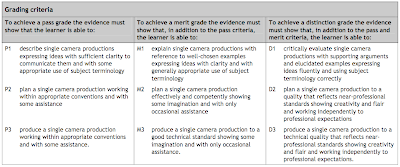
Single camera format is when a scene (or film) is filmed completely by one camera which moves to capture all the scenes needed. This technique has many advantages, one which is that all the film needed is accessible from one roll of film, and editors do not need to look through as many as 5 cameras for the right footage, as in multi-camera format. Another advantage of this technique is that the director has more control over each shot, as he/she can see this straight away as it is being filmed, rather than from several view-points. Single camera format is most often used to film when there is no live audience, as the viewers don't need to see a reaction. 'The Office,' uses single camera format which makes us feel as is we are there in the room with the actors, as we wouldn't move around as we do (given several veiw-points via more than one camera,) in multi camera format. This might be used to keep a scene flowing, for example, the 'Kill Bill' tracking shot flows as it follows Uma Therman around the building.
Multi camera format is where up to 5 cameras are used simultaneously to film one scene. The advantages of this format are that it is much cheaper than the single camera format, as more film can be taken at once it takes less time to film and gather more footage. Another advantage is that we can be shown the speech of one person, and the reaction of another, at the same time. We can also be shown various camera shots, for example: a close up of the speaker, a close-up of another person's reaction and then a full shot of the studio. This gives the audience perspective of where they are and what other people think about the scene in front of them. This technique also allows for mistakes or unwanted film to be shot, as it will still be there on another camera. This helps in live shows, where multi camera format is often used. It is also used in dramas and quiz shows. Multi camera format is used in dramas such as 'Being Human', quiz shows such as 'QI' and debate shows such as 'Question Time.'
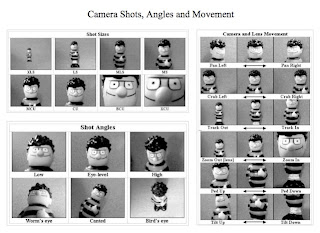 Task 2
Task 2A series drama is when each episode has a closed ending and completes the mini plot. Dr Who is an example of a series drama as each episode is a complete story which doesn't continue into the next episode and the story in it is completed with each TV show.
 Gok Wan: How To Look Good Naked, is a series show. The show finishes with a complete closed ending and in the next show, starts again with a new focus.
Gok Wan: How To Look Good Naked, is a series show. The show finishes with a complete closed ending and in the next show, starts again with a new focus.Task 3
Linear or sequential narrative structures-
We are shown the drama in a version of the events as they happened with the beginning, middle and the end (as in Todorov's theory) in the 'correct' order. This is used all the time in soaps, as it makes the show easy to understand and simple to follow, which is needed in soaps as they must appeal to the majority of audiences. The film, The Butterfly Effect starts with the beginning and shows us the events which lead us here.
Non linear or non-sequential narrative structures-
This is when it it shown from ay other design. We may be shown the same event from different POV's or or where the ending is shown and the film maker decides to tell us the story of how we got to that destination. The Peep Show and Lost use this often. It allows the audience to empathize with the characters whose view point we are shown.
Flashbacks-
The audience are shown a clip which is from one or more character's pasts. It is often to show a reason for a decision made by one of the characters in the character's present time.
Realist or anti realist-
Realist is realistic events which are plausible in real life such as in soaps. Anti-realist is things such as werewolves and vampires by using CGI which is used in films such as
Endings-
Open endings leave a mini-drama with a cliffhanger in which the drama is left with an ending which is unresolved. For example, each series of Dallas is left with an open ending which creates tension and suspense for the audience as we are desperate to resolve the mystery by watching more, this may be in a new series or new narrative.
A closed ending leaves the show with a resolve which finishes the show for the time-being. One film which uses this is Snow White, which leaves us with the resolve of a happily-ever-after and every question we may have answered, or able to answer ourselves.
Patterns of narrative:
Goal - orientated plot
Search or investigation
Journey
Climax
Range of information
Unrestricted- The audience know the outcome of the film before watching it, usually because it is based on a real-life event such as Titanic, Pearl Harbor, United 93 which are all based on well known events which the majority of viewers will know about.
Restricted- The audience learn about the plot at the same time as the characters do. It is a fictional story line and we do not know the outcome, e.g.- Adventureland, Panic Room.
Propp's Theory
Every narrative has a:
Hero
Helper
Villain
Damsel-in-distress
Todorov's Theory
Equilibrium
Disruption
Resolution
These may not appear in the traditional order, as sometimes the disruption is shown first to kick-start the film/show.
Subjective
This is when we are shown what is happening from out the viewpoint of a character or someone who is there in the action. When walking, the camera often shakes to suggest footsteps and is moved about fast and without fluid motions to make it seem more realistic as we would view it if we were there. The Peep Show uses this often.
Objective
We are shown what is happening from an outside viewpoint as if we are looking from the outside and the characters cannot see us. Most films and TV shows use this as it is the more traditional way of shooting any film.
Task 3a-
The film, Twilight has used the theory of equilibrium, disruption and resolution in a linear narative. In the beginning of the film, the main character, Bella Swan, moves to live with her father. This is the equilibrium as there are no problems or disruptions for the character in the film. The first minor disruption arrives when the character of Edward Cullen is introduced to the plot, he is a mystery and provides the film with an enigma to solve. This is later solved with the discovery that he is infact a vampire, and the two characters fall in love. The main disruption to the film occurs in the form of the villians- who try to kill the character of Bella. This must then be resolved to the final resolution of the villain being killed and Bella being safe.
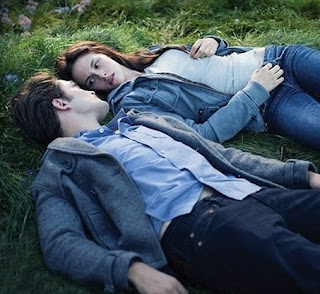 The film uses an anti-realist plot as the story line includes the fictional characters of vampires and werewolves, however, apart from this element, the remaining story line is realist as The film uses flashbacks when the character of Bella finally discovers that Edward is a vampire, to help the audience link this together as she did, as this is a restrictive drama- the audience have to work out the plot at the same time as the characters. It has an open ending as it is the first of a 4-part book series.
The film uses an anti-realist plot as the story line includes the fictional characters of vampires and werewolves, however, apart from this element, the remaining story line is realist as The film uses flashbacks when the character of Bella finally discovers that Edward is a vampire, to help the audience link this together as she did, as this is a restrictive drama- the audience have to work out the plot at the same time as the characters. It has an open ending as it is the first of a 4-part book series.It also uses Propp's theory of hero, villain damsel and distress. The character of Bella (Kristen Stewart) is the damsel in distress, Edward, (Robert Pattinson) is the hero, the Cullen family are the helper and the villians are the 'bad vampires'- James (Cam Gigandet), Victoria and Laurent.
Another film is Shrek. This film uses the theory of Todorov, as their is an equilibrium, disruption and resolution. At the start of the film, Shrek is without problem, living alone, the disruption is when the characters from the village move into his swamp. He then sets out to free himself of the squatters and has to rescue the princess from the dragon. The resolution is when gets the swamp back to himself. it uses an anti-realist plot including mythical creatures. The plot is also non-restricted as the audience learn the plot at the same time as the characters.
The film has a linear sequence as all the events are shown in chronological order and the ending is closed, although there are sequels, they each start with a new story line. Shrek uses Todorov's theory of equilibrium, disruption and resolution, with the main plot being goal orientated towards saving the Princess.
Task 4
Editing is also used in the single camera drama, Seven, to make it more interesting to watch. The opening titles are blurred and out of focus and appear to shake around the screen. As well as being more interesting to watch than still text, it gives the audience a clue to the genre of the drama they are about to watch as the blurriness has connotations of a horror or a thriller as we cannot see clearly what is happening unless we pay attention. Another detail is the red number 7 in the opening title. This colour is a signifier and connotes death and violence and gives us a clue to the genre. In the flashbacks, the images of a dead body and a hand holding two pills are flashed onto the screen extremely fast so the audience can make the link between the two images. They are also flashed up in time with the heartbeat sound effect, which makes it look very professional and also adds suspense.
| Grade | Social Class | Occupation | Job | Media |
| Grade A | Upper middle | Higher managerial, administrative or professional | Lawyer, politician, surgeon, judge | TV- Question Time, News, Newsnight Newspaper- Broadsheet Radio- BBC4, BBC7 Magazine- Hello, OK! Specialist magazines. |
| Grade B | Middle | Immediate managerial, administrative or professional | Bank manager, head teacher, dentist, doctor | TV- News Newspapers- Financial times, broadsheet Radio- BBC2 Magazine- OK! Hello, Heat |
| Grade C | Lower middle | Supervisory or clerical and junior managerial, administrative professional | Retail manager, secretary, clerical assistant, mortgage advisor | TV- Desperate housewives, Doc Martin Newspaper- Tabloid Radio- Real, BBC2 Magazine- Heat, Now, Closer |
| Grade C2 | Skilled working | Skilled manual workers | Plumber, electrician, engineer. | TV- X Factor, QI, Mock the Week Newspaper- Tabloid Radio- BBC1, Real Magazine- Heat, Now, Closer, Take A Break |
| Grade D | Unskilled Working | Semi and unskilled workers | Retail assistants, supermarket cashiers. | TV- X Factor, The Hills, Soaps Newspaper- The Sun, Evening Post Radio- BBC1, Kiss Magazine- Pick Me Up, Take A Break |
| Grade E | Lower levels of subsistence | Casual or lowest grade workers, pensioners and others who depend on the welfare state for their income | Unemployed | TV- Shameless, Trisha, Newspaper- The Sun, Daily Star Magazine- Bella, Take A Break, Pick Me Up, Soap Life |
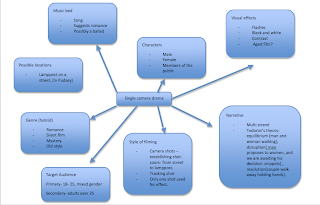
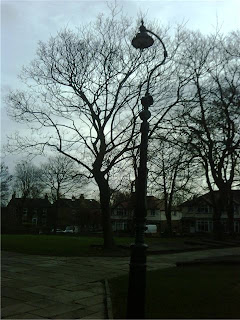
Task 11- Health and Safety
PGS Media : Risk Assessment
Risk assessment is a process of identifying possible risks and assessing their likelihood and severity. This might lead to further action being taken.
The first risk that our production team has to deal with is the weather. As we are filming on location, it means that we have to be very careful with the equipment, as we are unable to predict the weather, and we have specific filming days, Tuesday afternoon and Friday morning for two hours, we are very limited. Snow is a big factor, as we plan to use the snow in our film to make an impact on the mood of the scene. The snow affects the camera equipment, as we have to take care of the equipment to make sure that no damage is made. If there is ice on the pavement, it pushed the severity scale right up. The colder it is also affects our filming, as our cast won’t be able to perform as well.
Severity-Snow- M (Moderate)
Ice- S (Severe Risk)
Likely- Snow- VL (Very Likely)
Ice- VL (Very Likely)
Risk Factor- Snow- 3
Ice- 5
Because of the high risk factor of snow and ice, it means that we as a team have to be incredibly careful with the equipment. It also means that we have to plan very carefully when we are going to go out and film and make sure that our footwear is suitable. When we are using the ‘big’ Panasonic camera with the tripod, we have to think carefully if we need to take the ‘wheels attachment’ out as well. We must also be careful with the microphones which our actor/actresses must wear, as they are very sensitive to noise. The equipment must never be left unattended.
To make sure that there will be no accidents, we will split the equipment, so that each person is responsible for it, then we will take care of it. When the equipment is not being used, we carry a bag so that it can be placed in there, so it doesn't get damaged by the weather.
Another risk is the fact that we will be filming away from school. So this means that we will have to take extra care when crossing the road with the equipment. We also need to look out for any oncoming traffic, so that we can stop filming- as this affect our single camera drama.
Severity- L (Low)
Likely- P (Possible)
Risk Factor- 2
If required, we will just stop filming, and take extra care.
Very likely: VL
|
Title of production: Single camera drama
Locations: Booths yard, Pudsey. Outside school. Front of school.
Name of producer: Sarah Kerry, Christy Guy, Anisha Parmar
Tel : 0113 336 8700
| | Hazard | Present? | Severity? | Likelihood? | Risk Factor |
| 1 | Alcohol/Drugs | N | N | VU | 1 |
| 2 | Animals/insects | N | L | L | 1 |
| 3 | Audiences | N | N | VU | 1 |
| 4 | Camera/Mike cables | Y | N | VU | 1 |
| 5 | Confined spaces | N | N | VU | 1 |
| 6 | Derelict buildings/dangerous structures | N | N | VU | 1 |
| 7 | Fire/flammable materials | N | N | VU | 2 |
| 8 | Hazardous substances | N | N | VU | 1 |
| 9 | Heat/cold/extreme weather | Y | S | VL | 5 |
| 10 | Laser/strobe effects | N | N | VU | 1 |
| 11 | Machinery/industrial/crane/hoist | N | N | VU | 1 |
| 12 | Materials – glass, non-fire resistant | Y | N | VU | 1 |
| 13 | Noise – high sound levels | N | L | VU | 1 |
| 14 | Public/crowds | N | N | VU | 1 |
| 15 | Scaffold/rostra | N | N | VU | 1 |
| 16 | Smoking on set | N | N | U | 1 |
| 17 | Special effects/explosives | N | N | VU | 1 |
| 18 | Special needs (elderly, disabled, inexperienced) | N | N | VU | 1 |
| 19 | Stunts/dangerous activities | N | N | VU | 1 |
| 20 | Tall scenery/suspended ceilngs | N | N | VU | 1 |
| 21 | Vehicles/speed | N | N | VU | 1 |
| 22 | Water/proximity to water | N | N | VU | 1 |
| 23 | Working at heights | N | N | VU | 1 |
| 24 | Dangerous prop | N | N | U | 2 |
Task 9: Create a storyboard for your production


Task 10- Production schedule
| Filming: |
| |
| Date of shoot: | Content: | Captured by: |
| 04/12/2009 | Location shoot: Pudsey town centre. Year: 1960s. Casting: Mr Bradley and Mrs Burkinshaw | Sarah, Anisha and Christy Had to re-film due to unsuitable ambience. |
| 04/12/2009 | Location Shoot: Booth’s Yard Year: 1940s Casting: Sally and Elliot | Sarah Had to re-film because of sound quality. |
| 11/12/2009 | Location shoot: Front of School. Year: Present day Casting: Aimee and Lewis | Christy White balance on camera not turned on, therefore had to re-film. |
| 15/12/2009 | Location shoot: Outside school- Mount Pleasant Road. Year: 1970s Casting: Sally and Elliot | Anisha Had to re-film due to unsuitable footage due to weather. |
| 05/01/2010 | Location shoot: Front of school. Year: re-film of present day Casting: Hannah and Luke | Sarah Sound: Anisha |
| 19/01/2010 | Location shoot: Booths Yard Year: re-film of 1940s Casting: Anisha and Aaron | Sarah and Christy Sound: Anisha |
| 02/02/2010 | Location shoot: school grounds. Year: 1970s re-film. Casting: Sally and Elliot | Sarah Sound: Anisha |
| 09/02/2010 | Location shoot: Wesley Terrace, graveyard Narration of poem for open and closing. | Christy Sound: Anisha, Sarah and Christy |
| Completion of filming | 09/02/2010 | |
| Editing: |
|
| Date: | Completed: |
| 08/12/2009 | Importing and editing of 1960s footage. However, the footage doesn't look as authentic as it should be. So it may have to be re-filmed. Also the lighting is too bright. And there is a lot of ambience from passing traffic. |
| 08/12/2009 | Importing and editing of 1940s footage. However, the footage is ok, but the sound can’t be heard. Needs to be re-filmed. |
| 15/12/2009 | Importing and editing of present day. However, when we imported the footage, it seems that the snow has got into the lens, and the footage isn’t clear. |
| 18/12/2009 | Importing and editing of 1970s footage. Again, the snow and wind has meant that the footage isn’t to a high quality. And the white balance is too bright, because the snow has reflected a lot of light. |
| 05/01/2010 | Importing and editing of footage for the present day- re-film. The sound quality isn’t great, so I am going to lip-sync the voices over the footage. |
| 08/01/2010 | Editing of present day footage. |
| 12/01/2010 | Editing of footage (present day) - adding transitions. |
| 15/01/2010 | Editing of footage (present day) - adding music bed and editing of audio. Syncing the audio over the footage |
| 19/01/2010 | Importing 1940s footage- re-film- shortening down the footage |
| 22/01/2010 | Editing of 1940s footage. Recording of audio. Sequencing the footage |
| 29/01/2010 | Editing of 1940s footage. Adding music and editing audio, and syncing over the footage. |
| 02/02/2010 | Importing and editing 1970s re-film. Shortening down the footage. |
| 03/02/2010 | Adding music bed to 1970s section, editing music and footage. |
| 05/02/2010 | Found music bed for opening and ending credits. |
| 09/02/2010 | Importing of narration footage. Also recorded the audio for the footage and have started to edit the footage down. |
| 10/02/2010 | Cut down the narration footage, and made sure that the MP3 recording was suitable |
| 11/02/2010 | Editing of the sound recording. |
| /02/2010 | |
| Completion date | |




I'm a bit stuck on the remarks part of my treatment for the drama, I'm not sure if what I have included is relevant to this part of the treatment.
ReplyDeleteI'm also not sure if I've included enough media terminology in my treatment...
I also can't get the final few sections to stop being underlined. Other than that I'm really enjoying TV+Film.
Hope it's ok.